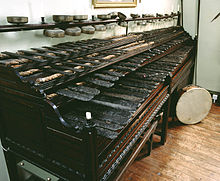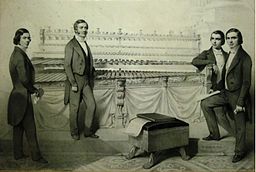- Musical Stones of Skiddaw
-
The Musical Stones of Skiddaw is a lithophone made of a type of hornfels rock found in Cumbria, England. Constructed between 1827 and 1840, the instrument has entertained royalty; it is now housed at the Keswick Museum and Art Gallery in Cumbria.
Contents
The Crosthwaite Musical Stones
Inventor Peter Crosthwaite was the first to conceive of a stone xylophone. Born at Dale Head, Thirlmere, in 1735, he joined the British East India Company after a brief and unhappy stint in his family's wool business. He became a naval commander, master of the gunboat Otter, protecting the Company's ships against Malay pirates. He returned to England in 1765 and undertook customs duties on the coast before returning to Keswick in 1779 and setting up a museum there in 1780.
Crosthwaite was an eccentric and keen inventor. His inventions included a fire-escaping machine, a portable bathing machine, a cure for smoking chimneys, a swinging machine for the benefit of health, a roasting machine and a cork-bottomed lifeboat. He never patented any of his inventions, however and, in the case of his lifeboat, someone else took the credit for the device.
On June 11, 1785, Crosthwaite was walking around the area of Skiddaw and he made a startling discovery; there was music in the rocks.
He told people that the first six 'music stones' he found on that day were in perfect tune; the remaining ten of the set took six months to find, with Crosthwaite working twelve hours a day to tune, carefully chipping away at the stone until the desired note rang true. He carved into each stone the letter corresponding to the note which the stone sounded. The result was a sort of xylophone, known as the Musical Stones. In his museum at the bottom of Keswick's Market Place, Crosthwaite set up mirrors near the windows to see approaching carriages. When a carriage neared, he played a rudimentary tune on his Musical Stones and his daughter and an old woman banged a drum, rattled a gong and a played a barrel organ. This cacophony of noise flooding out of the Museum was meant to attract the attention of the carriage passengers so they might pay a shilling and come and look round.
Joseph Richardson & Sons and the Rock, Bell & Steel Band
Joseph Richardson (1790), a stonemason and gifted amateur musician from Keswick, continued the experiment in lithophones after noting the nearly-musical tones of some of the rock he worked with. He began to test the various rocks of the Lake District for their note and collected ones that gave a pure, resonant ring, forming them into a sequence.
At 1827 in Thornthwaite, he found that the rocks of Skiddaw had the best tone of all and endeavoured to produce an instrument on a larger scale than Crosthwaites, which would have every musical note. The geological name for the rock both Crosthwaite and Richardson used for their instruments is hornfels. It took Richardson almost thirteen years to collect and shape enough individual notes of hornfels to make an eight-octave range. The massive task of assembling this instrument consumed Joseph so absolutely that he and his family were reduced to poverty. Finally, in 1840, he completed his own lithophone, now known as 'The Richardson Set'.
Joseph enlisted his three sons and they began practising with the instrument and giving concerts locally. Having gained support and acclaim in the Keswick region, they set off on a three-week tour of the major northern towns of England. Their reception and immediate success meant that they did not see their home again for three years. One local newspaper noted that "everyone appeared much delighted with the sweet sound elicited from the rugged and uncouth looking and unique instrument". Their success encouraged them to head for London, where "the wonderful merits of your admirable instrument cannot fail to be well-received by the London public who are very musical people".
The repertoire included selections from Handel, Beethoven and Mozart and arrangements of waltzes, quadrilles, galops and polkas. Considerable variation in tone was achieved by using different methods of striking the notes, creating a blend of organ, piano, harp and flute sounds, though the full power of the instrument had to be withheld because of the fear of shattering the concert hall windows. The concerts were popular: The richness and sweetness of the tones astonished onlookers. An 1846 newspaper advertisement for a performance in Luton states that the range of the instrument went from the warble of a lark to the deep bass of a funeral bell. Journalist Minnie Broatch, writing in 1842, explains that the musical stones look more or less like hammered dulcimers, but on a gargantuan scale.
To increase the musical range, the instrument was updated in the mid 1840s with two rows of steel bars, Swiss bells and large kick drums, and became Richardson & Sons, Rock, Bell and Steel Band. On 23 February 1848 the Richardsons played at Buckingham Palace, by command of Queen Victoria. Prince Albert was present, and a large assembly of English and foreign noblemen and women. The Band was well received; indeed, two of the pieces were requested for an encore. According to The Times, it proved one of the most extraordinary and novel performances of the Metropolis. As a result, the Queen requested two further performances. However, although very impressed overall, Victoria was not amused by the sound of the Alpine bells.
Over sixty concerts were given in London alone and the Band toured all over Britain and, subsequently, in France, Germany and Italy, being transported by train. A concert trip to America was planned, but Robert, the youngest son and the most talented player, became ill just before the date of departure and died of pneumonia. The tour was abandoned, and the instrument was packed away. Subsequently, the instrument was given to Keswick Museum in 1917 by the grandson of Joseph Richardson, Richardson Henderson after an unsuccessful attempt by him to revive the family business.
Richardson is buried at Kensal Green Cemetery in London. As well as a gravestone, Joseph also has a monument there to mark his life and his achievement. The monument is the tallest obelisk in the cemetery and it reads:
In Memory of Joseph Richardson, formerly of Underskiddaw, Keswick, Cumberland Inventor of the Instruments of the Rock, Bell and Steel Band
Later sets of Musical Stones include the Till Family Rock Band, exhibited and performed upon by Daniel Till of Keswick and his two sons in 1881 at The Crystal Palace. The Tills later toured America extensively and one of their instruments is now held in the Metropolitan Museum, New York. The Abraham Brothers of Keswick, famous for their mountaineering and photography, collected a set of fifty-eight stones in the late nineteenth century, which took them twelve years and which they exhibited in their photography shop on Lake Road and gave concerts in a hall nearby.
The Story Continues
Recently the Richardsons' stones have gone on tour again. The first of these 21st century Musical Stones tours took place in September 2005. Keswick Museum was approached by Grizedale Arts - a contemporary art commissioning agency near Coniston - to collaborate with the musician and artist Brian Dewan from Catskill, New York State. Dewan composed seven pieces. This suite of music lasted about an hour and was performed outside, on the shores of Coniston Water, looking out across the lake towards Brantwood, the former home of the great writer, artist and social reformer John Ruskin. Ruskin loved the sound of Cumbrian lithophones and even commissioned Daniel Till to build him a set of his own. This set is now on display in the Ruskin Museum in Coniston, Cumbria.
The lakeside performance by Brian Dewan and Jamie Barnes was part of the Coniston Water Festival 2005 - a country sports and art festival restarted by Grizedale Arts to allow the local community to continue the event after 2007.
A special frame and sound box was constructed to mount the stones for the performance. Brian used 35 of the 60 slate notes for his composition. These notes correspond to the white notes on a piano. The performance was amplified and the sounds of the stones drifted across the lake and into Coniston village. The performance was also broadcast over a short wave radio station.
The performance was repeated at the University of Leeds in May 2006; new music was performed and recorded as part as the Liverpool Biennial 2006. In these performances the Stones were joined by a Chinese classical orchestra, and the bells of Liverpool Cathedral.
In January 2006 the Musical Stones reached a large national audience when they were heavily featured as part of a BBC BBC Radio 4 documentary on Cumbrian musical stones presented by the top classical percussionist Evelyn Glennie. The documentary was entitled The World's First Rock Band. In June 2006 the Stones went global when they were featured on National Public Radio across America.
Keswick Museum and Art Gallery are also involved with a large three-year project set up by Yorkshire Quarry Arts based at The University of Leeds. It is an interdisciplinary project to find out why hornfels has musical properties, carry out historical research on the Cumbrian sets of musical stones and organise a series of performances. The Musical Stones of Skiddaw have been played in several events for Yorkshire Quarry Arts.
In 2007 and 2008 Keswick Museum and Art Gallery worked with the music charity Soundwave and Changeling Productions to produce a theatrical performance entitled 'The Musical Stonemason - A Cumbrian Wayang'. The show told the story of how the Musical Stones were discovered by Peter Crosthwaite and made famous by Joseph Richardson. It was produced as a 'Wayang' - an Indonesian-style shadow puppetry play and featured a full 'Gamelan' – set of Indonesian orchestral instruments. The show was performed at the Royal Festival Hall, London and The Sage Gateshead in 2007 as well as several shows across Cumbria in 2008.
Soundwave, Changeling Productions and Keswick Museum and Art Gallery are continuing their unique collaboration as they deliver a two-year education project which uses the Musical Stones and the interests of Peter Crosthwaite to teach Cumbrian school children across the curriculum. This project has been generously financed in the main by a Heritage Lottery Fund ‘Your Heritage’ grant.
Keswick Museum and Art Gallery hope that all these new projects will help bring the Musical Stones to new audiences and keep this fascinating story alive for another 220 years at least.
See also
- Lithophone
- Tuned Percussion
- Xylophone
- Marimba
References
- Keswick Museum Website
- Musical Stones on MySpace
- The Musical Stones Blog
- Rock Music, M.C. Fagg, Pitt Rivers Museum, ISBN 0-902793-39-X
- The stones being played in the museum.
External links
Video
Categories:- Music museums
Wikimedia Foundation. 2010.


